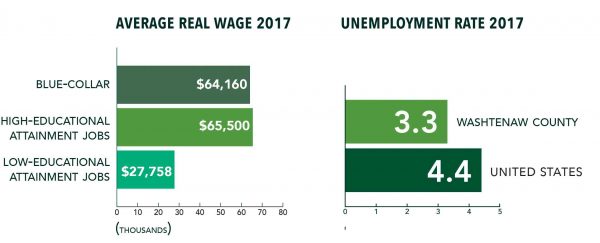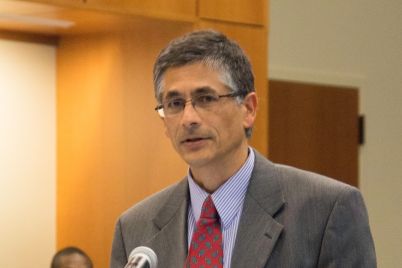
by Suni Jo Roberts
Deputy Editor
A low unemployment rate and increasing wage growth signify Washtenaw County is well into its economic recovery, which was part of the information included in an economic report delivered by two University of Michigan economists to the economic club at Washtenaw Community College on Thursday, March 29.
The report: “The Economic Outlook for Washtenaw County in 2018-20” was prepared by Gabriel Ehrlich, George Fulton, Donald Grimes and Michael McWilliams of the Research Seminar of Quantitative Economics within the College of Literature, Science and the Arts at the University of Michigan.
Washtenaw County’s 2017 unemployment rate, of 3.3 percent, is lower than the U.S.’s of 4.4 percent which is attributed to the strong performance in state government job growth at the University of Michigan and Eastern Michigan University. Additionally, Washtenaw County has outpaced the State of Michigan in terms of job growth since 2000, according to the report.
Washtenaw County is unique in its position as home to two major universities which is reflected in a highly educated population. Between 2012-2016, 55 percent of adults ages 18-65 had a bachelor’s degree or higher, compared with 32 percent of the U.S. population in the same age bracket.
The economic recovery has favored this group of people as the real wages of high-educational attainment jobs reached $56,683 in 2017, which was slightly below its peak in 2007 before the financial crisis. Compare this to the average real wage for low-educational attainment jobs at $27,758. Low-educational attainment jobs include those that don’t typically require higher education such as retail trade, leisure and hospitality services and business support services and account for 23-24 percent of jobs in the county.
“The missing piece of the puzzle in Washtenaw’s economic success story over the past eight years has been the uneven pace of wage growth,” said Gabriel Ehrlich, director of the Research Seminar of Quantitative Economics at the University of Michigan.
“Even though 55 percent of our working age population has a bachelor’s degree or more, 45 percent of our population does not,” said Donald Grimes, assistant director of the Center for Labor Market Research at the University of Michigan. “It is unsound economically, morally to leave that 45 percent of the population behind.” Grimes continued: “So, now we are in the auditorium of Washtenaw Community College, this is the institution that can help raise the living standard of the 45 percent of the population that does not have a bachelor’s degree. This institution has a really important role to play.”
The UM economists met with WCC’s economic club after their presentation to answer questions from students on the economic recovery of Detroit, economic theories and programs of study.

